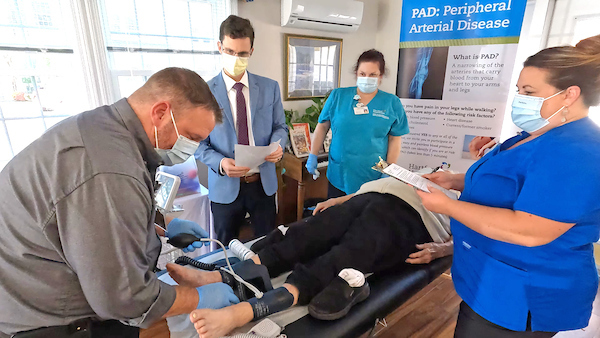<< Back
East Region Forms Community Advisory Council

September 21, 2023
To best address community health issues and take advantage of opportunities to meet needs, East Region teams are going directly to the source.
Under the guidance of Anesta Williams, director of human-centered care, and Joe Zuzel, director of community health in the East, the Patient & Family Advisory Council (PFAC) serving Backus and Windham hospitals is morphing into a Community Advisory Council. This group will tap diverse Hartford HealthCare community partners for feedback.
“We realized our PFACs didn’t really represent the population (of the area),” Zuzel explains. “We wanted a global, community-wide voice made up of diverse individuals from all walks of life, representing everything from intellectual/physical disabilities to ethnicities to sexual orientation.”
Traditionally, PFACs bring the voice of patients and families to the table to help address barriers that can interfere with optimal care. Members include hospital colleagues, former patients and their family members and community members. The model, however, isn’t optimal.
“The healthcare landscape is changing, and, in response, we are constantly assessing our impact on the communities we serve,” Williams notes. “As we embarked on our 2023 strategic imperatives related to access, affordability, equity and excellence, we recognized an opportunity to explore innovative alternatives to elicit feedback.”
It’s a natural progression for systems seeking input from those outside hospital walls.
“Hearing the voice of the consumer across the spectrum of care relationships is critical to informing our quality, safety, experience and innovation strategies,” says Gerard Lupacchino, senior vice president for human experience. “As we evolve to community advisory councils, we will learn more, not only from those who chose to come here for care, but also from those who haven’t, or haven’t yet, chosen HHC as their care provider.”
First, research; then, action
“We started by saying ‘What can we do differently to measure the impact of completed work and meet community needs?’” Williams says.
University of Michigan graduate students tackled research into CAC best practices , what helped them succeed and potential limitations. At the same time, Zuzel and Williams talked with community partners to “gain a better understanding of the barriers HHC’s East Region has faced in the past,” Williams says.
“Why are there individuals who are not seeking care? What are the barriers? What are the opportunities? We want to be supportive, not prescriptive. Then we can bridge that gap.”
They combined that information with identified specific needs, barriers and community demographics to create the CACstructure.
The CAC will:
- Provide feedback from a diverse group regarding ongoing community health issues and opportunities.
- Be made up of current and former patients, family members and caregivers, plus community representatives.
- Improve overall patient-centered care by sharing patient/family experiences and perspectives.
- Identify existing gaps and increase community engagement with the system.
Hearing all voices
While the PFAC consisted of those who interacted with the system, the CAC will include those who have never stepped foot inside an HHC facility.
“The CAC will be more robust by focusing on the community perspective rather than just the patient’s,” Zuzel says. “That was just one perspective. We need to broaden the perspectives to parts of the community currently going unheard.”
The CAC is recruiting eight to 10 members, who must be able to commit to serving one to two years and attending monthly meetings. The group will have a higher ratio of community members to maintain its community focus and sustain engagement.
Ultimately, CAC goals are to align with the Community Health Improvement Plan, a document put together every three years to identify major barriers to health in each geographic area, and create solutions.
The anticipated community benefits are:
- Increased number of new initiatives and associations with community groups
- Increased use of community services (ex. Meals on Wheels)
- Increased customer satisfaction regarding the region’s community involvement
“This work has the potential to effect improved outcomes for patients and increase our success in the East region,” Williams says. “Additionally, this aligns with FY23 goals to increase access and improve affordability.”